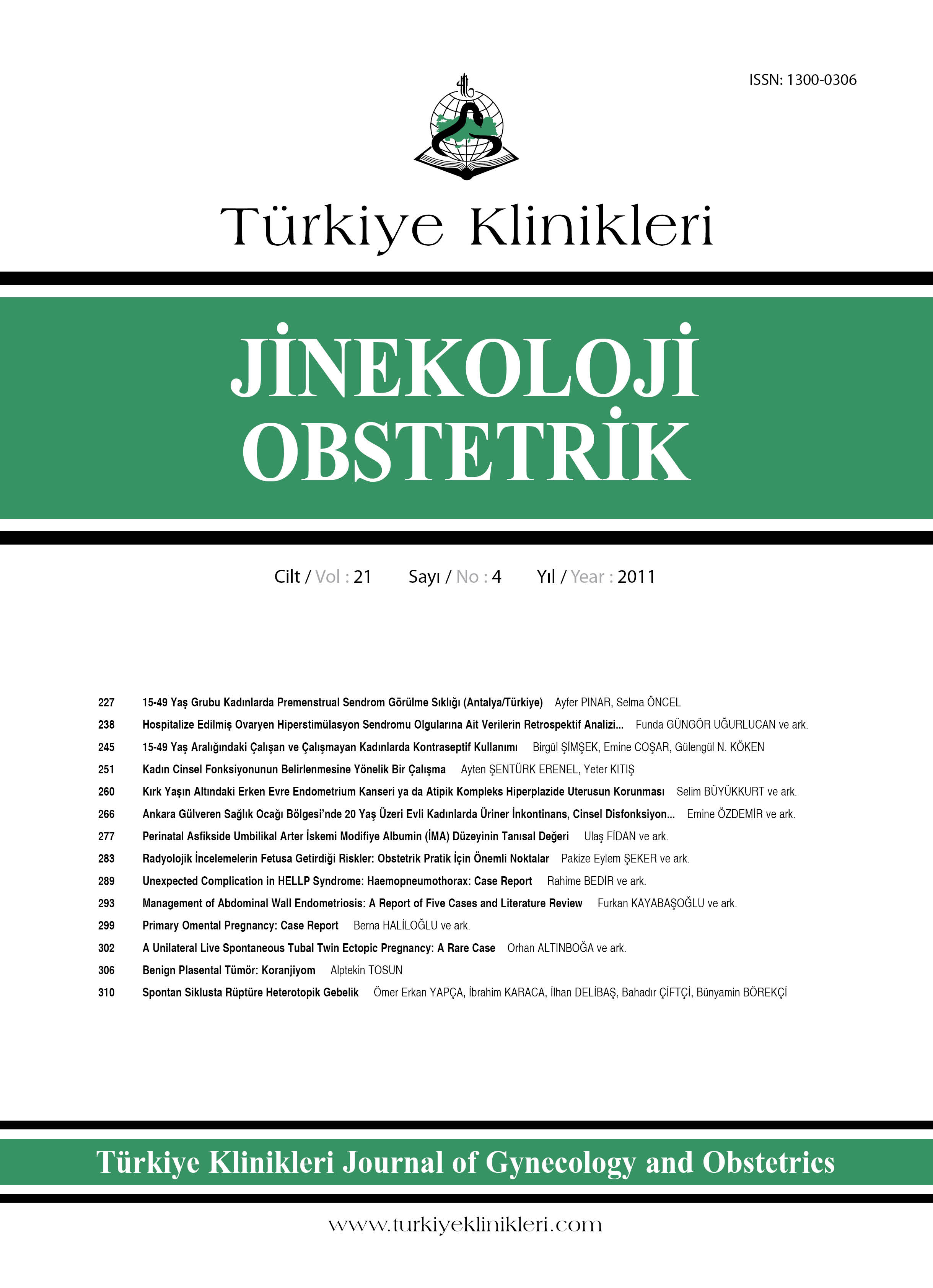Open Access
Peer Reviewed
ORIGINAL RESEARCH
3473 Viewed1137 Downloaded
Contraceptive Usage of 15-49 Years Old Working and Non-Working Women
15-49 Yaş Aralığındaki Çalışan ve Çalışmayan Kadınlarda Kontraseptif Kullanımı
Turkiye Klinikleri J Gynecol Obst. 2011;21(4):245-50
Article Language: TR
Copyright Ⓒ 2025 by Türkiye Klinikleri. This is an open access article under the CC BY-NC-ND license (http://creativecommons.org/licenses/by-nc-nd/4.0/)
ÖZET
Amaç: Bu çalışma, 15-49 yaş arası doğurganlık çağındaki, çalışan ve çalışmayan kadınların doğurganlık özelliklerini, kontraseptif kullanımını belirlemek, birbirleriyle karşılaştırmak ve etki eden faktörleri değerlendirmek amacıyla planlandı. Gereç ve Yöntemler: Araştırmaya 150 çalışan ve 150 çalışmayan olmak üzere toplam 300 evli kadın katıldı. Araştırmanın amacı katılımcılara açıklandı ve kabul edenlere yüz yüze görüşme tekniği ile anket formu uygulandı. Anket formu, sosyodemografik özellikleri, doğurganlık özellikleri, aile planlaması bilgi düzeyi, kontraseptif yöntem özellikleri ile ilgili sorulardan oluşmaktaydı. İstatistiksel analiz için Pearson (ki-kare) testi ve Student-t testi kullanıldı. p< 0.05 anlamlı olarak kabul edildi. Bulgular: Araştırmanın sonuçlarına göre kadınların yaş ortalaması 32.6 olarak saptandı. Çalışan kadınların %62'si yüksekokul mezunu iken, çalışmayan kadınların %82'sinin ilköğretim ve altı eğitim düzeyinde olduğu görüldü. Çalışan kadınların %86.7'si, çalışmayan kadınların %75.3'ü kontraseptif yöntem kullanmaktaydı. Çalışan kadınlar %33.8 ile hem rahim içi araç, hem de kondomu aynı yüzde ile tercih ederken, çalışmayan kadınların %46 ile geri çekme ve tüp ligasyonu tercih ettiği görüldü. Sonuç: Araştırmamızda çalışanlarda etkin yöntem kullanım oranı (%83.1) yüksek bulunmuştur. Kadınların eğitim durumlarının ve sosyal statülerinin yükseltilmesi ile aile planlanması yöntemlerinin kullanımının artacağını düşünmekteyiz.
Amaç: Bu çalışma, 15-49 yaş arası doğurganlık çağındaki, çalışan ve çalışmayan kadınların doğurganlık özelliklerini, kontraseptif kullanımını belirlemek, birbirleriyle karşılaştırmak ve etki eden faktörleri değerlendirmek amacıyla planlandı. Gereç ve Yöntemler: Araştırmaya 150 çalışan ve 150 çalışmayan olmak üzere toplam 300 evli kadın katıldı. Araştırmanın amacı katılımcılara açıklandı ve kabul edenlere yüz yüze görüşme tekniği ile anket formu uygulandı. Anket formu, sosyodemografik özellikleri, doğurganlık özellikleri, aile planlaması bilgi düzeyi, kontraseptif yöntem özellikleri ile ilgili sorulardan oluşmaktaydı. İstatistiksel analiz için Pearson (ki-kare) testi ve Student-t testi kullanıldı. p< 0.05 anlamlı olarak kabul edildi. Bulgular: Araştırmanın sonuçlarına göre kadınların yaş ortalaması 32.6 olarak saptandı. Çalışan kadınların %62'si yüksekokul mezunu iken, çalışmayan kadınların %82'sinin ilköğretim ve altı eğitim düzeyinde olduğu görüldü. Çalışan kadınların %86.7'si, çalışmayan kadınların %75.3'ü kontraseptif yöntem kullanmaktaydı. Çalışan kadınlar %33.8 ile hem rahim içi araç, hem de kondomu aynı yüzde ile tercih ederken, çalışmayan kadınların %46 ile geri çekme ve tüp ligasyonu tercih ettiği görüldü. Sonuç: Araştırmamızda çalışanlarda etkin yöntem kullanım oranı (%83.1) yüksek bulunmuştur. Kadınların eğitim durumlarının ve sosyal statülerinin yükseltilmesi ile aile planlanması yöntemlerinin kullanımının artacağını düşünmekteyiz.
ANAHTAR KELİMELER: Aile planlaması hizmetleri; doğum kontrolü
ABSTRACT
Objective: This study was conducted to determine and compare the prolificacy characteristics and use of contraception methods of employed and unemployed women, whose ages are between 15-49 years at reproductive group, and to evaluate the effective factors. Material and Methods: The study consists of two groups, 150 employed women, and 150 unemployed women, a total of 300 women, were recruited in the study. A standard questionnaire with the face-to-face interview method was applied for data collection. The questionnaire consisted of questions, asking in detail about sociodemographic properties, prolificacy characteristics, contraception use, level of knowledge about family planning, and contraceptive methods. Pearson (chi-square) test, Student-t test were used in analyses of the data. Statistic significance is quoted at the p< 0.05 level. Results: According to the results of this study, mean age of women is 32.6%. Sixty two percent of employed women have a high education level (university), 82% of unemployed women have low education level (primary school and below). 86.7% of employed women and 75.3% of unemployed women practiced contraception. 33.8% of employed women preferred to use Copper T and condom with the same percent while 46% of unemployed women use withdrawal method and tubal ligation. Conclusion: In this study, it is found that most of employed women (83.1%) use effective contraception. It is believed that when educational level and socioeconomic status of women is improved, the correct use of contraceptive methods will also be increased and a healthy society will be constituted.
Objective: This study was conducted to determine and compare the prolificacy characteristics and use of contraception methods of employed and unemployed women, whose ages are between 15-49 years at reproductive group, and to evaluate the effective factors. Material and Methods: The study consists of two groups, 150 employed women, and 150 unemployed women, a total of 300 women, were recruited in the study. A standard questionnaire with the face-to-face interview method was applied for data collection. The questionnaire consisted of questions, asking in detail about sociodemographic properties, prolificacy characteristics, contraception use, level of knowledge about family planning, and contraceptive methods. Pearson (chi-square) test, Student-t test were used in analyses of the data. Statistic significance is quoted at the p< 0.05 level. Results: According to the results of this study, mean age of women is 32.6%. Sixty two percent of employed women have a high education level (university), 82% of unemployed women have low education level (primary school and below). 86.7% of employed women and 75.3% of unemployed women practiced contraception. 33.8% of employed women preferred to use Copper T and condom with the same percent while 46% of unemployed women use withdrawal method and tubal ligation. Conclusion: In this study, it is found that most of employed women (83.1%) use effective contraception. It is believed that when educational level and socioeconomic status of women is improved, the correct use of contraceptive methods will also be increased and a healthy society will be constituted.
MENU
POPULAR ARTICLES
MOST DOWNLOADED ARTICLES





This journal is licensed under a Creative Commons Attribution-NonCommercial-NoDerivatives 4.0 International License.










